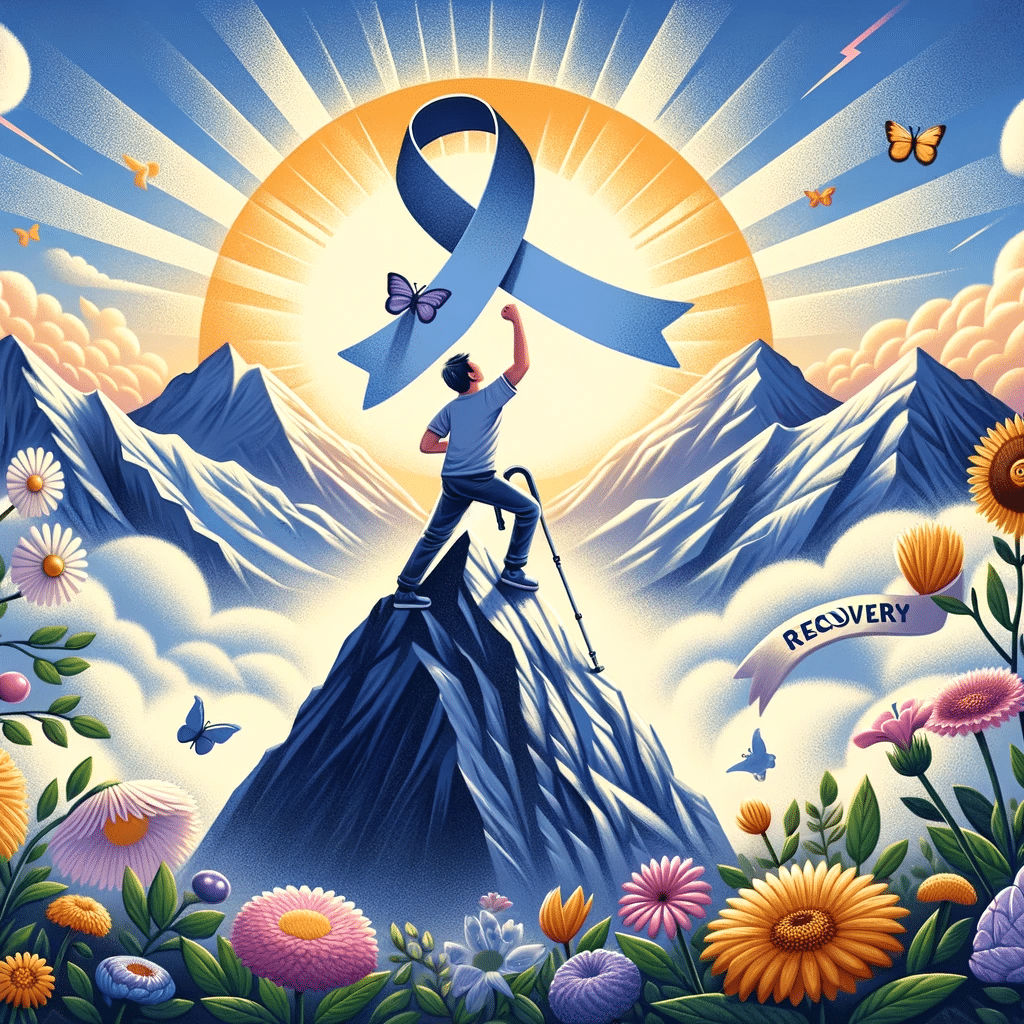A Solitary Confinement
A true story about Guillain-Barre Syndrome by
Robin Sheppard
A true story about Guillain-Barre Syndrome by
Robin Sheppard
December, 2023
Reclaiming Life After a GBS Diagnosis
Welcome to “The Unseen Battle: Living with Guillain-Barre Syndrome.” This blog is a journey into the lives of those touched by Guillain-Barre Syndrome (GBS), a rare neurological disorder that can turn lives upside down. From initial symptoms to the long road of recovery, GBS challenges individuals in ways that go beyond the physical. It’s a battle often fought in silence, away from the understanding of many. Here, we aim to shed light on these personal struggles and the incredible resilience shown by GBS survivors. As we delve into their stories, we explore not just the hardships, but also the triumphs in reclaiming life after a diagnosis.

Recurrent GBS and Intense Symptoms: One individual shares their struggle with recurring GBS, experiencing severe “lightning strike” sensations and sleeplessness despite taking gabapentin.
Physical Challenges and Dietary Concerns: Another person diagnosed with the Aman variant of GBS discusses ongoing stiffness and walking difficulties, despite physiotherapy and a lack of Intravenous Immunoglobulin (IVIg) treatment. They seek advice for exercises to improve walking and note issues with oily foods.
Diverse Causes: Various sufferers report different triggers for their GBS:
One case followed a kidney/pancreas transplant and a stomach bug.
Another developed after eating a contaminated chicken sandwich, leading to campylobacter infection.
Stressful life events and emotional trauma were considered potential triggers by one person.
Food poisoning, viral illnesses like the flu, COVID-19, and reactions to vaccinations, including the shingles vaccine, were mentioned as possible causes.
Exercise and Recovery: Balancing Effort and Caution in Guillain-Barre Syndrome
Exercise plays a crucial role in the recovery journey of Guillain-Barre Syndrome (GBS) patients. Their experiences shed light on how physical activity aids in regaining mobility and balance:
Individualised Exercise Routines: One sufferer emphasises the benefits of physical therapy exercises, noting significant improvements. This aligns with research suggesting that tailored exercise programs can enhance recovery in GBS patients.
Persistence and Adaptation: Another individual, in their late 60s, shares a commitment to walking a mile every day, despite pain and difficulty. This example of persistence highlights the importance of adapting exercise routines to personal capabilities and conditions.
Aquatic Therapy: Swimming and exercises in a walk-in pool were found beneficial by a GBS patient. Aquatic therapy is often recommended for its low impact and support for weakened muscle.
Emphasising Regular Exercise: The consensus among these stories is clear: consistent and appropriate exercise is key to recovery. Whether through structured physical therapy or self-guided activities, maintaining an active lifestyle is crucial for regaining lost abilities.
Recovery times vary widely among Guillain-Barre Syndrome patients, ranging from days to years. These shared experiences underline the importance of patience, perseverance, and the right kind of physical activities in overcoming the challenges posed by Guillain-Barre Syndrome.
Individual Responses to Foods: Personal experiences vary widely. Some individuals find avoiding certain foods like almonds, dried fruits, spicy foods, and alcohol, particularly beer, helps reduce symptoms like foot pain. Others report tolerating moderate alcohol, like wine, without issue.
The Anti-Inflammatory Diet: Several Guillain-Barre Syndrome sufferers recommend an anti-inflammatory diet, which typically involves reducing processed foods, red meat, and refined sugars, while increasing fruits, vegetables, and whole grain.
High Protein and Low Sugar Diets: Some individuals feel better on a higher protein diet. For those with diabetes, reducing sugar intake is crucial, as sugary foods can exacerbate symptoms.
Avoiding Certain Foods in Autoimmune Conditions: It’s suggested that people with autoimmune diseases, including GBS, might benefit from avoiding nightshade vegetables like potatoes, tomatoes, and eggplants, as they may worsen symptoms.
Overall Balanced Nutrition: Generally, a balanced diet rich in fruits, vegetables, whole-grain breads, and low-fat dairy products is advised for strength and recovery.
Remember, dietary needs can vary greatly among individuals with GBS, and what works for one person may not work for another. It’s important to consult with a healthcare professional before making significant dietary changes.
Intravenous Immunoglobulin (IVIG) therapy, a common treatment for various immune and neurological disorders, can have a range of side effects as shared by patients and documented in medical research:
Common Side Effects: Headaches and sensitivity to light are frequently reported. These side effects can be managed with hydration, over-the-counter pain relief like Tylenol, and rest.
Fatigue and Skin Reactions: Some patients experience significant tiredness post-IVIG treatment. Skin reactions, such as rashes on the belly, hands, and face, are also observed. While these are generally non-severe, continuous monitoring by a medical team is important.
Gastrointestinal Issues: Nausea and vomiting can occur, especially in children. Managing these symptoms might require additional medical intervention.
Rare and Serious Side Effects: While most side effects are mild and manageable, there can be serious adverse events like seizures, aseptic meningitis, and in rare cases, nephrotoxicity (kidney damage).
Overall Benefit-Risk Assessment: Despite these side effects, many patients find IVIG beneficial, noting improvements in mobility and overall health. It’s important to weigh the benefits of IVIG against its potential side effects and consult healthcare professionals for personalised advice.
The mental health impact of Guillain-Barre Syndrome (GBS) and Chronic Inflammatory Demyelinating Polyneuropathy (CIDP) can be profound, often leaving individuals feeling trapped in their own bodies due to pain and numbness. Here’s an insight into their experiences and some resources for support:
Shared Feelings of Isolation and Despair: Many GBS and CIDP patients feel overwhelmed by the physical limitations and chronic pain, leading to feelings of being a burden and experiencing deep depression and anxiety.
Searching for Effective Treatments: While IVIG is a common treatment, it may not be effective for everyone. Alternatives like plasmapheresis or Rituximab have been beneficial for some, underscoring the need for personalised treatment plans.
The Importance of Mental Fortitude: Staying positive and giving it your best every day is a common piece of advice from those who have been through similar struggles. However, maintaining a positive outlook can be challenging amidst severe pain and disability.
The Impact on Caregivers: GBS and CIDP also deeply affect caregivers, who often struggle with seeing their loved ones in pain and feeling the pressure of providing constant care.
Seeking Professional Help and Community Support: Engaging with mental health professionals and connecting with others who have similar experiences can be immensely helpful. Organisations like the GBS/CIDP Foundation International offer community support and resources for those affected.
Mental Health Charities: Organisations like Mind (mind.org.uk) and Mental Health America (mhanational.org) provide resources and support for those struggling with mental health issues.
It’s important for both patients and caregivers to seek help and not to hesitate in discussing mental health concerns with healthcare providers. Remember, you are not alone in this journey.
Living with Guillain-Barre Syndrome brings significant changes to daily life and social interactions, often leading to feelings of being a burden and losing spontaneity:
Loss of Spontaneity and Independence: GBS sufferers commonly miss being able to engage in impromptu plans like meeting friends on short notice or going for quick errands. Accessibility challenges like fitting a wheelchair through doors, finding ADA accessible facilities, and transferring into cars require meticulous planning, making spontaneous outings difficult.
Transitioning from Helper to Being Helped: Many Guillain-Barre Syndrome sufferers accustomed to being active and independent, struggle with the shift to needing assistance for basic tasks and feel like they are more of a burden than a contributor in social settings.
Emotional Struggles: The physical limitations and dependency can lead to intense feelings of worthlessness and loss, with many experiencing moments of intense sadness and frustration.
Finding Strength in Resilience: Despite these challenges, there’s a sense of shared resilience. Sufferers encourage each other to not let Guillaine-Barre Syndrome define them, but to use their experiences to teach others about surviving and navigating a world that’s not always accessible. They emphasise the importance of maintaining a positive attitude despite limitations.
Seeking Support and Understanding: It’s crucial for GBS patients to seek support from family, friends, and healthcare professionals. Understanding and empathy from loved ones can make a significant difference in coping with these challenges.
Living with GBS requires adapting to a new way of life, but it also opens avenues for personal growth, resilience, and teaching others about overcoming adversity.
The recovery journey from Guillain-Barre Syndrome (GBS) is unique for each individual, as seen in these shared stories of resilience and hope:
Celebrating Small Victories: One person shared their achievement of going on a 2km hike, a significant milestone considering their previous paralysis. Their gradual return to work and regaining independence in daily activities highlights the slow yet steady progress possible after GBS.
Finding Therapy in Everyday Activities: Another individual found that including therapy in daily routines, like household chores, significantly boosted their confidence and strength recovery.
Relatable Experiences: A GBS survivor described their experience as strikingly similar to the first story, emphasising the shared challenges like fine motor skills difficulties. The support of family members, like helping with personal care or make-up, was a crucial element in their recovery.
Age and Recovery Pace: Another person’s story illustrates that age can influence the recovery rate. At 79, they experienced a slower recovery but remained grateful for each bit of progress and mobility improvement made.
These stories underscore the importance of perseverance, family support, and finding joy in small achievements. They remind us that recovery from GBS can be a long and varied journey, but with determination and support, significant improvements are possible.
We hope that the stories shared here have enlightened and inspired you. The path to recovery from Guillain-Barre Syndrome is unique for each individual, filled with challenges and victories. It’s a reminder of the incredible strength and adaptability of the human spirit. If you or someone you know is battling GBS, remember, you are not alone. There is hope, there is progress, and above all, there is a community ready to support you. Keep fighting, keep believing, and keep reclaiming your life, one step at a time.
There is a book about Robins journey and personal road to recovery that can be purchased from Amazon here

As we conclude our exploration of the challenges and triumphs faced by those living with Guillain-Barre Syndrome, we would like to bring to your attention a remarkable book that delves deep into the personal journey of a GBS survivor.
“A Solitary Confinement: Always look on the bright side” is a compelling narrative that not only sheds light on the struggles of living with Guillain-Barre Syndrome but also offers hope and inspiration for recovery.
This is one man’s attempt to chronicle the reality and the challenge presented to anyone unlucky enough to be struck down by Guillain-Barre Syndrome. It is not intended to provide technical solutions or an exhaustive guide to the recovery process, but it does convey a very clear understanding of what it feels like to be on the inside of the illness.
With humour and defiance Robin Sheppard chronicles his personal journey and by anecdote and observation builds a patchwork, in vivid colour, of the view from the interior.
The physical debility he endured served only to sharpen his sense of the absurd. His easy writing style is deceptive as he pours metaphorical scorn on the worst that GBS could throw at him and laughs right back in defiance.
If “The diving bell and the butterfly” made you weep then this will make you laugh and cry in equal measure.
It’s a compelling read which tugs at the heart strings and gladdens the soul. An alchemy of words and experience, sharply observed.
This book is an invaluable resource for anyone seeking to understand the emotional and physical complexities of this condition. We highly recommend it as a source of support and encouragement. For those interested in delving further into this inspiring story, the book is available for purchase on Amazon. Visit Amazon today to get your copy and immerse yourself in this extraordinary journey of resilience and hope, by Robin Sheppard.